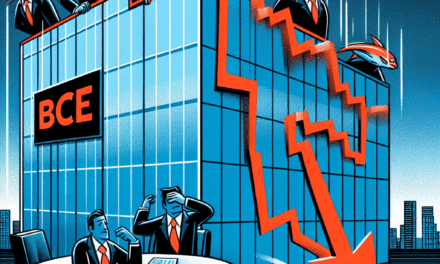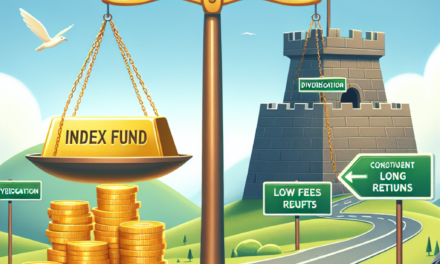“Value Stocks Rebound: Navigating Opportunities with Caution.”
Introduction
The anticipated comeback of value stocks has garnered significant attention among investors as market dynamics shift and economic conditions evolve. After a prolonged period of growth stock dominance, characterized by soaring valuations and rapid technological advancements, many analysts are now suggesting that value stocks—traditionally seen as undervalued companies with solid fundamentals—may be poised for a resurgence. This cautious outlook is fueled by factors such as rising interest rates, inflationary pressures, and a potential economic slowdown, which could lead investors to seek stability and income in more established companies. However, while the prospects for value stocks appear promising, uncertainties remain, necessitating a careful approach to investment strategies in this changing landscape.
Value Stocks: A Historical Perspective
Value stocks, characterized by their lower price-to-earnings ratios and perceived undervaluation relative to their intrinsic worth, have long been a cornerstone of investment strategies. Historically, these stocks have provided investors with opportunities for substantial returns, particularly during periods of economic recovery and market corrections. The appeal of value investing lies in its fundamental premise: purchasing stocks that are trading for less than their true value, thereby positioning oneself for potential gains as the market eventually recognizes their worth.
In the aftermath of the dot-com bubble in the early 2000s, value stocks experienced a resurgence as investors sought refuge from the volatility of growth stocks, which had been heavily inflated by speculative trading. This shift was not merely a reaction to market conditions; it was also a reflection of the underlying economic fundamentals. As companies with solid earnings and stable business models began to outperform their more speculative counterparts, the value investing philosophy gained traction. This trend continued through the financial crisis of 2008, when value stocks once again demonstrated resilience, as investors gravitated towards companies with strong balance sheets and consistent cash flows.
However, the landscape for value stocks has not always been favorable. The prolonged bull market that followed the 2008 crisis saw growth stocks, particularly in the technology sector, dominate the investment narrative. This period of low interest rates and quantitative easing created an environment where investors were willing to pay a premium for growth, often at the expense of value stocks. Consequently, many value-oriented investors found themselves sidelined, as the performance gap between growth and value stocks widened significantly. This divergence raised questions about the long-term viability of the value investing approach, leading some to speculate that the traditional metrics used to identify value may no longer hold the same relevance in a rapidly evolving market.
Despite these challenges, historical data suggests that value stocks tend to outperform their growth counterparts over the long term. This phenomenon can be attributed to the cyclical nature of markets, where periods of growth are often followed by corrections that favor undervalued assets. As economic conditions shift, the inherent characteristics of value stocks—such as lower volatility and greater dividend yields—become increasingly attractive to risk-averse investors. Moreover, the recent uptick in inflation and rising interest rates may signal a turning point for value stocks, as higher borrowing costs could dampen the growth prospects of highly leveraged companies, thereby restoring interest in fundamentally sound investments.
As we look ahead, the anticipated comeback of value stocks is met with cautious optimism. While the historical performance of value investing provides a compelling case for its resurgence, it is essential to recognize the unique challenges posed by the current economic environment. Factors such as geopolitical tensions, supply chain disruptions, and shifting consumer behaviors could influence market dynamics in unpredictable ways. Therefore, investors must approach the value investing landscape with a discerning eye, carefully evaluating individual companies and their potential for recovery.
In conclusion, the historical perspective on value stocks reveals a complex interplay between market cycles and investor sentiment. While the past offers valuable insights, the future remains uncertain. As value stocks navigate the evolving economic landscape, their potential for a comeback will depend on a myriad of factors, including macroeconomic trends and the ability of companies to adapt to changing market conditions. Thus, a balanced approach that considers both historical performance and current realities will be crucial for investors seeking to capitalize on the anticipated resurgence of value stocks.
Key Indicators for Value Stock Recovery
As the financial landscape continues to evolve, investors are increasingly turning their attention to value stocks, which have historically provided robust returns during periods of economic recovery. However, the anticipated comeback of these stocks is not without its complexities, and several key indicators must be closely monitored to gauge the potential for a sustained recovery. Understanding these indicators can provide valuable insights for investors looking to navigate the shifting market dynamics.
One of the primary indicators to consider is the interest rate environment. Historically, value stocks tend to perform well when interest rates are low or declining, as this scenario often leads to increased consumer spending and business investment. Conversely, rising interest rates can dampen economic growth and negatively impact the performance of value stocks. As central banks around the world adjust their monetary policies in response to inflationary pressures, investors should remain vigilant about interest rate trends and their implications for value stock performance.
In addition to interest rates, inflation rates serve as another critical indicator. Value stocks often thrive in environments where inflation is stable or moderate, as this allows companies to pass on costs to consumers without significantly eroding profit margins. However, if inflation continues to rise unchecked, it could lead to increased costs for businesses and reduced consumer purchasing power, ultimately hindering the recovery of value stocks. Therefore, monitoring inflation trends and the responses of central banks will be essential for assessing the viability of value stock investments.
Moreover, the overall economic growth trajectory plays a pivotal role in the recovery of value stocks. Economic indicators such as GDP growth, employment rates, and consumer confidence can provide insights into the health of the economy and the potential for value stocks to rebound. A robust economic recovery, characterized by strong GDP growth and declining unemployment rates, typically bodes well for value stocks, as it signals increased demand for goods and services. Conversely, signs of economic stagnation or contraction could pose significant challenges for these stocks, making it imperative for investors to stay informed about economic developments.
Another important factor to consider is the performance of growth stocks relative to value stocks. In recent years, growth stocks have dominated the market, often overshadowing their value counterparts. However, a shift in investor sentiment towards value stocks could signal a broader market correction, providing an opportunity for value stocks to regain their footing. Monitoring the performance of growth versus value stocks can offer valuable insights into market trends and investor preferences, helping investors make informed decisions about their portfolios.
Lastly, sector performance should not be overlooked when evaluating the potential recovery of value stocks. Certain sectors, such as financials, energy, and industrials, are often more closely associated with value investing. As the economy recovers, these sectors may experience a resurgence, driven by increased demand and improved fundamentals. Therefore, keeping an eye on sector-specific trends and developments can provide additional context for assessing the recovery potential of value stocks.
In conclusion, while the anticipated comeback of value stocks presents an intriguing opportunity for investors, it is essential to approach this potential recovery with caution. By closely monitoring key indicators such as interest rates, inflation, economic growth, the performance of growth stocks, and sector dynamics, investors can better position themselves to navigate the complexities of the market and make informed investment decisions. As the financial landscape continues to evolve, a nuanced understanding of these indicators will be crucial for capitalizing on the potential resurgence of value stocks.
Risks Associated with Value Stock Investments
As investors increasingly turn their attention to value stocks, it is essential to consider the inherent risks associated with this investment strategy. While value stocks, characterized by their lower price-to-earnings ratios and perceived undervaluation, may seem appealing, they are not without their challenges. Understanding these risks can help investors make informed decisions and navigate the complexities of the market.
One of the primary risks associated with value stocks is the potential for value traps. A value trap occurs when a stock appears undervalued based on traditional metrics but fails to appreciate in value due to underlying issues within the company or its industry. For instance, a company may have a low price-to-earnings ratio, but if it is facing declining revenues, increasing competition, or significant operational challenges, the stock may remain stagnant or even decline further. Consequently, investors may find themselves holding onto a stock that does not deliver the expected returns, leading to frustration and potential losses.
Moreover, value stocks often come from sectors that are experiencing cyclical downturns or structural changes. Industries such as retail, energy, and manufacturing can be particularly susceptible to economic fluctuations. For example, a value stock in the retail sector may seem attractive during a period of economic recovery, but if consumer preferences shift towards e-commerce, traditional brick-and-mortar retailers may struggle to adapt. This shift can result in prolonged underperformance for value stocks in these sectors, making it crucial for investors to conduct thorough research and analysis before committing capital.
In addition to sector-specific risks, macroeconomic factors can also impact the performance of value stocks. Interest rates, inflation, and geopolitical events can create an unpredictable environment for investors. For instance, rising interest rates can lead to increased borrowing costs for companies, which may negatively affect their profitability and, consequently, their stock prices. Similarly, inflation can erode purchasing power, impacting consumer spending and, in turn, the revenues of value-oriented companies. Investors must remain vigilant and consider how these broader economic trends may influence their value stock investments.
Another risk to consider is the potential for prolonged underperformance relative to growth stocks. In recent years, growth stocks have dominated the market, often delivering substantial returns that have outpaced their value counterparts. This trend can create a psychological barrier for investors, as they may be hesitant to invest in value stocks that have not performed well in the short term. The fear of missing out on growth opportunities can lead to a lack of patience, causing investors to abandon their value strategies prematurely. It is essential for investors to maintain a long-term perspective and resist the temptation to chase short-term gains.
Lastly, the lack of liquidity in certain value stocks can pose a significant risk. Smaller companies or those in niche markets may not have the same trading volume as larger, more established firms. This lack of liquidity can make it challenging for investors to enter or exit positions without significantly impacting the stock price. As a result, investors should be cautious when investing in less liquid value stocks, as they may face difficulties in executing trades at favorable prices.
In conclusion, while the anticipated comeback of value stocks presents an intriguing opportunity for investors, it is crucial to remain aware of the associated risks. By understanding the potential pitfalls, including value traps, sector-specific challenges, macroeconomic influences, the risk of underperformance relative to growth stocks, and liquidity concerns, investors can better navigate the complexities of value investing. Ultimately, a cautious and informed approach will be essential for those looking to capitalize on the potential resurgence of value stocks in the market.
Sector Analysis: Where to Find Value Opportunities
As the financial landscape continues to evolve, investors are increasingly turning their attention to value stocks, which have historically provided a buffer against market volatility. The anticipated comeback of these stocks is rooted in a variety of factors, including rising interest rates, inflationary pressures, and a potential shift in consumer behavior. However, while the allure of value investing is strong, a cautious outlook is warranted, particularly when analyzing specific sectors for potential opportunities.
One sector that has garnered attention is the financial services industry. With interest rates on the rise, banks and financial institutions stand to benefit from improved net interest margins. This environment creates a fertile ground for value stocks, particularly those that have been trading at lower price-to-earnings ratios compared to their historical averages. Moreover, as economic conditions stabilize, the demand for loans and financial services is expected to increase, further enhancing the profitability of these institutions. However, investors should remain vigilant, as regulatory changes and economic uncertainties could pose risks to this sector.
Another area worth exploring is the energy sector, which has experienced significant volatility in recent years. The transition to renewable energy sources has led to a reevaluation of traditional energy companies, many of which are now trading at attractive valuations. As global energy demands continue to rise, particularly in emerging markets, established energy firms that have adapted their business models to include sustainable practices may present compelling value opportunities. Nevertheless, investors must consider the potential for geopolitical tensions and fluctuating commodity prices, which could impact the stability of this sector.
The consumer staples sector also warrants attention, as it typically exhibits resilience during economic downturns. Companies in this sector often provide essential goods that consumers rely on, making them less susceptible to economic fluctuations. As inflationary pressures persist, consumers may gravitate towards value-oriented brands, thereby benefiting companies that offer affordable alternatives. However, while the consumer staples sector may provide a degree of stability, investors should be cautious of rising input costs and supply chain disruptions that could erode profit margins.
In addition to these sectors, the healthcare industry presents another avenue for value investing. With an aging population and increasing healthcare demands, companies that provide essential medical services and products are likely to experience sustained growth. Many healthcare stocks are currently undervalued, particularly those involved in biotechnology and pharmaceuticals, which have the potential for significant breakthroughs. However, investors should remain aware of the regulatory landscape and the potential for changes in healthcare policy that could impact profitability.
Lastly, the industrial sector is worth considering, particularly as infrastructure spending gains momentum. Governments around the world are increasingly focused on revitalizing infrastructure, which could lead to increased demand for industrial goods and services. Companies that are well-positioned to capitalize on this trend may offer attractive value opportunities. However, investors should be cautious of potential supply chain challenges and labor shortages that could hinder growth in this sector.
In conclusion, while the anticipated comeback of value stocks presents a promising opportunity for investors, a careful analysis of specific sectors is essential. By focusing on the financial services, energy, consumer staples, healthcare, and industrial sectors, investors can identify potential value opportunities. However, it is crucial to approach these investments with a cautious outlook, considering the inherent risks and uncertainties that may impact performance. As the market continues to evolve, maintaining a balanced perspective will be key to navigating the complexities of value investing.
The Role of Interest Rates in Value Stock Performance
The anticipated comeback of value stocks has garnered significant attention in recent months, particularly as investors seek to navigate the complexities of the current economic landscape. One of the most critical factors influencing the performance of value stocks is the prevailing interest rate environment. As central banks around the world adjust their monetary policies in response to inflationary pressures and economic recovery, the implications for value stocks become increasingly pronounced. Understanding the relationship between interest rates and value stock performance is essential for investors looking to make informed decisions.
Historically, value stocks, which are characterized by their lower price-to-earnings ratios and attractive dividend yields, tend to perform well in environments of rising interest rates. This phenomenon can be attributed to several interconnected factors. First, as interest rates increase, the cost of borrowing rises, which can lead to a slowdown in economic growth. In such scenarios, investors often gravitate towards companies with strong fundamentals and stable earnings, which are hallmarks of value stocks. These companies are typically better positioned to weather economic downturns, making them appealing to risk-averse investors.
Moreover, rising interest rates can have a direct impact on the discount rates used in valuation models. When interest rates rise, the present value of future cash flows decreases, which can disproportionately affect growth stocks that rely heavily on future earnings projections. In contrast, value stocks, which often have more predictable cash flows and dividends, may be less sensitive to these changes. Consequently, as the market recalibrates its expectations in response to higher interest rates, value stocks may emerge as attractive investment opportunities.
However, it is essential to approach this anticipated comeback with caution. While the historical relationship between interest rates and value stock performance suggests a favorable outlook, the current economic environment is marked by unique challenges. For instance, the pace and magnitude of interest rate hikes by central banks can create volatility in the markets, leading to uncertainty among investors. Additionally, the ongoing geopolitical tensions and supply chain disruptions may further complicate the economic recovery, potentially dampening the performance of value stocks.
Furthermore, the rotation from growth to value stocks is not guaranteed to be smooth or linear. Investors must remain vigilant, as market sentiment can shift rapidly in response to new economic data or changes in monetary policy. For example, if inflation persists at elevated levels, central banks may be compelled to adopt more aggressive tightening measures, which could lead to increased market volatility and impact the performance of value stocks. Therefore, while the potential for a value stock resurgence exists, it is crucial for investors to maintain a diversified portfolio and consider the broader economic context.
In conclusion, the role of interest rates in value stock performance is a multifaceted issue that requires careful consideration. As interest rates rise, value stocks may benefit from their inherent stability and attractive valuations. However, the current economic landscape presents a host of uncertainties that could influence this dynamic. Investors should remain cautious and informed, recognizing that while the anticipated comeback of value stocks may be on the horizon, the path forward is fraught with challenges that necessitate a prudent and measured approach.
Comparing Growth and Value Stocks in Today’s Market
In the current financial landscape, the debate between growth and value stocks has gained renewed attention, particularly as investors seek to navigate the complexities of an evolving market. Growth stocks, characterized by their potential for above-average earnings expansion, have long been favored for their ability to deliver substantial returns. However, as economic conditions shift, value stocks—those trading at a lower price relative to their fundamentals—are beginning to emerge as a compelling alternative. This shift prompts a closer examination of the characteristics and performance of both categories in today’s market.
To begin with, growth stocks have historically attracted investors due to their promise of rapid revenue and earnings growth. Companies in technology, biotechnology, and other innovative sectors often exemplify this category, as they reinvest profits to fuel expansion rather than distribute dividends. However, the recent tightening of monetary policy and rising interest rates have introduced headwinds for growth stocks. As borrowing costs increase, the future cash flows of these companies become less attractive when discounted back to their present value. Consequently, many investors are reassessing their positions, leading to a potential recalibration of expectations for growth-oriented investments.
In contrast, value stocks present a different narrative. These stocks are typically associated with established companies that may be experiencing temporary setbacks or are undervalued due to market sentiment. As economic uncertainties loom, value stocks often provide a sense of stability, appealing to risk-averse investors. The current market environment, marked by volatility and inflationary pressures, has prompted a resurgence of interest in these stocks. Investors are increasingly drawn to companies with strong balance sheets, consistent cash flows, and attractive dividend yields, which can offer a buffer against market fluctuations.
Moreover, the performance of value stocks has shown resilience in periods of economic recovery. Historical data suggests that value stocks tend to outperform growth stocks during market recoveries, as investors shift their focus toward companies that can deliver tangible results. This trend is particularly relevant in the context of the anticipated economic rebound following the disruptions caused by the pandemic. As consumer spending rebounds and supply chains stabilize, value stocks may benefit from increased demand and improved profitability.
However, it is essential to approach the anticipated comeback of value stocks with caution. While the current market dynamics may favor value investing, the landscape remains fluid. Factors such as geopolitical tensions, ongoing supply chain challenges, and the potential for further interest rate hikes could impact the performance of both growth and value stocks. Therefore, investors must remain vigilant and adaptable, carefully evaluating the fundamentals of individual companies rather than relying solely on broad categorizations.
In conclusion, the comparison between growth and value stocks in today’s market reveals a complex interplay of factors influencing investor sentiment and performance. While growth stocks have historically dominated the investment narrative, the current economic climate has sparked renewed interest in value stocks, which offer stability and potential for recovery. As investors navigate this evolving landscape, a balanced approach that considers the unique characteristics and risks associated with each category will be crucial. Ultimately, the anticipated comeback of value stocks may provide opportunities for those willing to look beyond traditional growth narratives, but a cautious outlook remains essential in an unpredictable market.
Strategies for Investing in Value Stocks Amid Uncertainty
As the financial landscape continues to evolve, investors are increasingly turning their attention to value stocks, which have historically offered a buffer against market volatility. However, the anticipated comeback of these stocks is tempered by a cautious outlook, necessitating a strategic approach to investing in this sector. To navigate the complexities of the current market environment, investors must adopt a multifaceted strategy that balances risk and opportunity.
First and foremost, it is essential for investors to conduct thorough fundamental analysis when evaluating potential value stocks. This involves scrutinizing financial statements, assessing earnings potential, and understanding the underlying business model. By focusing on companies with strong balance sheets, consistent cash flow, and a history of profitability, investors can identify those that are undervalued relative to their intrinsic worth. Moreover, it is prudent to consider the broader economic context, as macroeconomic factors such as interest rates, inflation, and consumer sentiment can significantly impact the performance of value stocks.
In addition to fundamental analysis, diversification remains a cornerstone of any investment strategy, particularly in uncertain times. By spreading investments across various sectors and industries, investors can mitigate the risks associated with individual stocks. This approach not only helps to cushion against potential losses but also allows for exposure to different growth opportunities. For instance, while traditional value sectors such as utilities and consumer staples may provide stability, investors might also consider emerging industries that exhibit value characteristics, such as renewable energy or technology firms with strong cash flows.
Furthermore, patience is a critical virtue when investing in value stocks. Unlike growth stocks, which may experience rapid price appreciation, value stocks often require time to realize their full potential. Investors should be prepared for periods of underperformance, as market sentiment can take time to shift. By maintaining a long-term perspective and resisting the urge to react impulsively to short-term market fluctuations, investors can position themselves to benefit from the eventual recovery of undervalued stocks.
Another important strategy involves keeping abreast of market trends and economic indicators that may signal a shift in investor sentiment. For example, signs of economic recovery, such as improving employment figures or rising consumer confidence, can create a favorable environment for value stocks. Conversely, understanding the potential risks associated with rising interest rates or geopolitical tensions can help investors make informed decisions about when to enter or exit positions. Staying informed allows investors to adapt their strategies in response to changing market conditions, thereby enhancing their chances of success.
Moreover, incorporating a margin of safety into investment decisions can provide an additional layer of protection. This principle, popularized by value investing legends such as Benjamin Graham, emphasizes the importance of purchasing stocks at a price significantly below their intrinsic value. By doing so, investors can cushion themselves against unforeseen market downturns and increase the likelihood of achieving favorable returns over time.
In conclusion, while the anticipated comeback of value stocks presents a compelling opportunity for investors, it is essential to approach this sector with caution and strategic foresight. By conducting thorough fundamental analysis, diversifying investments, exercising patience, staying informed about market trends, and incorporating a margin of safety, investors can navigate the uncertainties of the current market landscape. Ultimately, a disciplined and informed approach will be key to capitalizing on the potential resurgence of value stocks in the coming years.
Q&A
1. **What are value stocks?**
Value stocks are shares of companies that are considered undervalued compared to their fundamentals, often characterized by low price-to-earnings (P/E) ratios and high dividend yields.
2. **Why is there anticipation for a comeback of value stocks?**
Investors are anticipating a comeback due to rising interest rates and inflation, which may lead to a shift away from growth stocks that have benefited from low borrowing costs.
3. **What factors contribute to a cautious outlook on value stocks?**
Factors include economic uncertainty, potential recession risks, and the possibility that growth stocks may continue to outperform due to technological advancements and consumer trends.
4. **How do interest rates affect value stocks?**
Higher interest rates can increase borrowing costs for companies, potentially impacting their profitability, but they may also make value stocks more attractive as investors seek stable returns.
5. **What sectors are typically associated with value stocks?**
Sectors such as financials, utilities, energy, and consumer staples are often associated with value stocks, as they tend to have stable earnings and dividends.
6. **What role does market sentiment play in the performance of value stocks?**
Market sentiment can significantly impact value stocks; if investors become more risk-averse, they may favor value stocks over growth stocks, leading to increased demand and price appreciation.
7. **What should investors consider before investing in value stocks?**
Investors should consider the overall economic environment, company fundamentals, sector performance, and their own risk tolerance before investing in value stocks.
Conclusion
The anticipated comeback of value stocks presents a cautiously optimistic outlook, driven by potential shifts in economic conditions and investor sentiment. While value stocks may benefit from rising interest rates and inflationary pressures that could favor companies with strong fundamentals and stable earnings, uncertainties such as geopolitical tensions, market volatility, and changing consumer behaviors warrant a careful approach. Investors should remain vigilant, balancing the allure of value opportunities with the inherent risks, ensuring a diversified strategy that accounts for both potential gains and market fluctuations.





